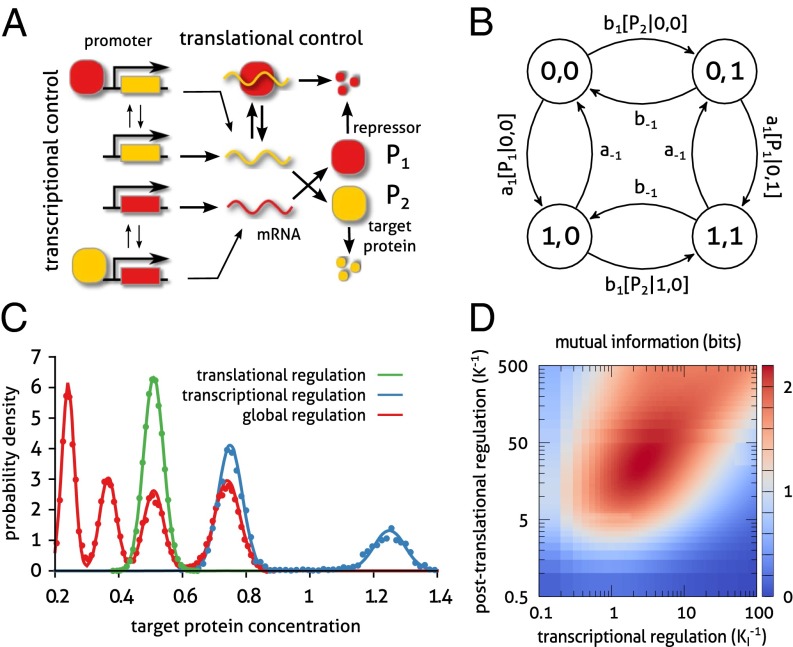Fig. 3.
Global control of gene expression promotes multimodality. (A) Noncooperative transcriptional regulation of two mutually repressing promoters including translational regulation which is mediated by binding of the repressor protein (red) to the mRNA species of the target protein (yellow). (B) The transition graph of the CME for the two-promoter network derived from Eq. 4 contains four slow states: (0,0) – no TF bound; (1,0) – repressor  bound; (0,1) – target
bound; (0,1) – target  bound; and (1,1) – both TFs bound. The parameters
bound; and (1,1) – both TFs bound. The parameters  and
and  correspond to the rate constants of DNA binding and unbinding of repressor and target proteins, respectively. (C) We compare the effect of exclusive translational (green), exclusive transcriptional (blue), and global control (red) on the modality of the target protein distributions: the conditional LNA (solid) predicts that these are uni-, bi-, and tetramodal, respectively, which is in excellent agreement with stochastic simulation of the full network via SSA (dotted). (D) We analyze the mutual information shared between repressor and target proteins (as a measure of regulation), calculated from the conditional LNA as a function of the inverse promoter binding constant (K) and the inverse mRNA inhibition constant
correspond to the rate constants of DNA binding and unbinding of repressor and target proteins, respectively. (C) We compare the effect of exclusive translational (green), exclusive transcriptional (blue), and global control (red) on the modality of the target protein distributions: the conditional LNA (solid) predicts that these are uni-, bi-, and tetramodal, respectively, which is in excellent agreement with stochastic simulation of the full network via SSA (dotted). (D) We analyze the mutual information shared between repressor and target proteins (as a measure of regulation), calculated from the conditional LNA as a function of the inverse promoter binding constant (K) and the inverse mRNA inhibition constant  . We find that optimization of the mutual information is a tradeoff between both types of regulation (
. We find that optimization of the mutual information is a tradeoff between both types of regulation ( ,
,  , 2 bits of information). The optimal target protein distribution corresponds to (B, red). Parameter values are given in SI Appendix, Table S2.
, 2 bits of information). The optimal target protein distribution corresponds to (B, red). Parameter values are given in SI Appendix, Table S2.

